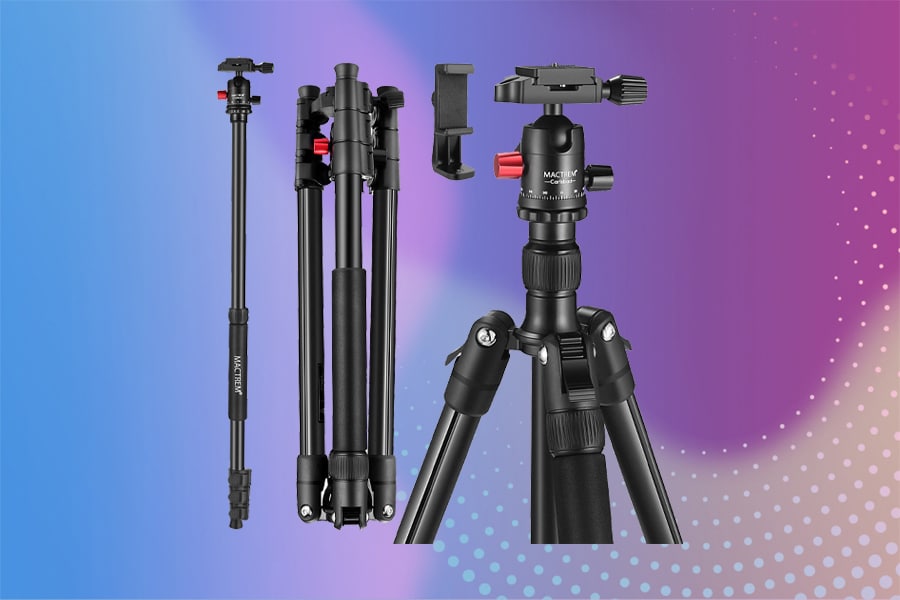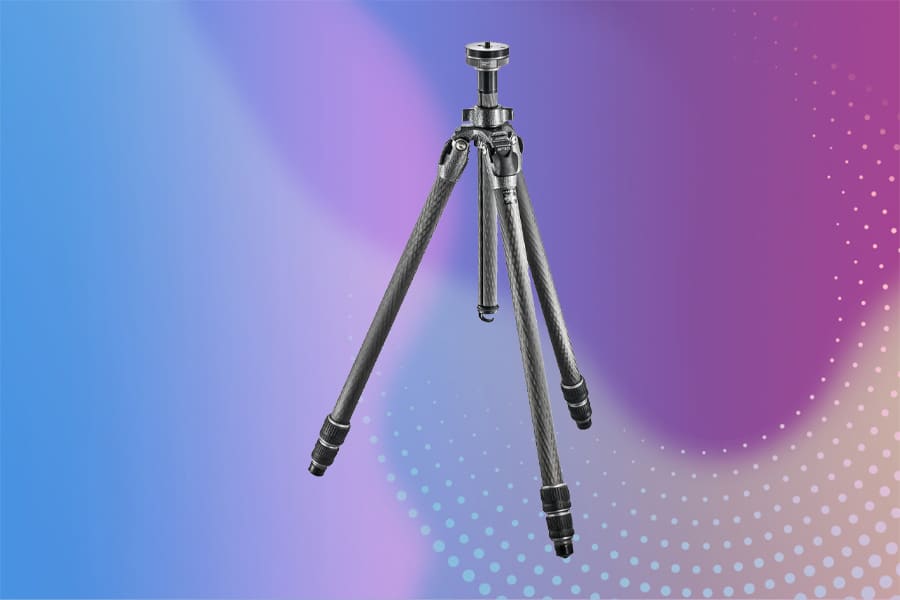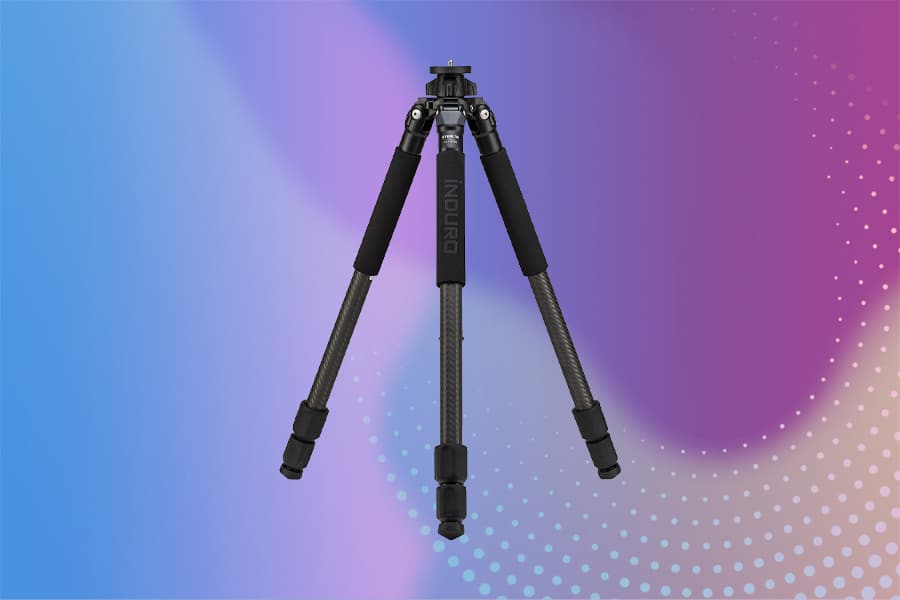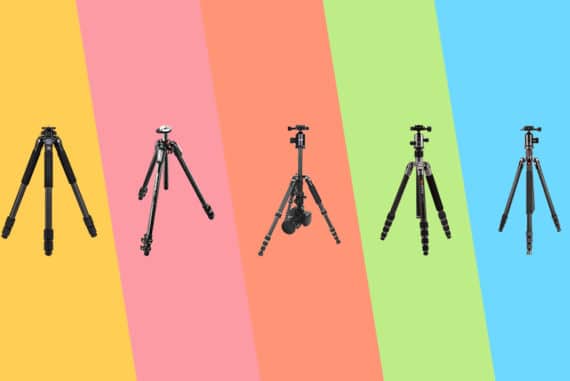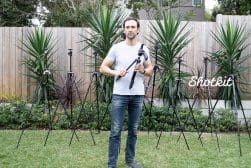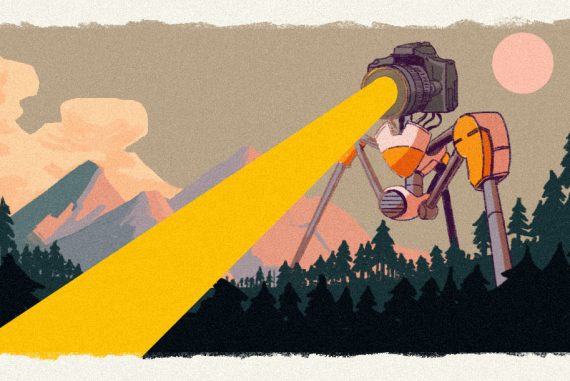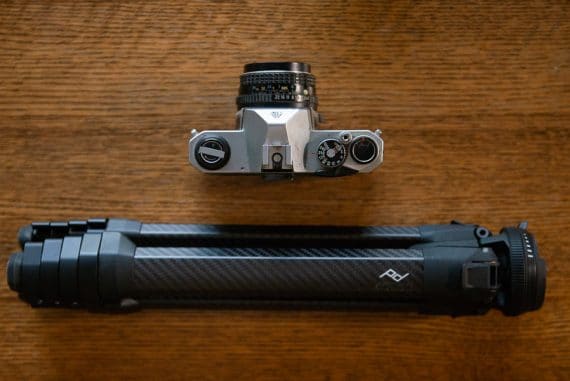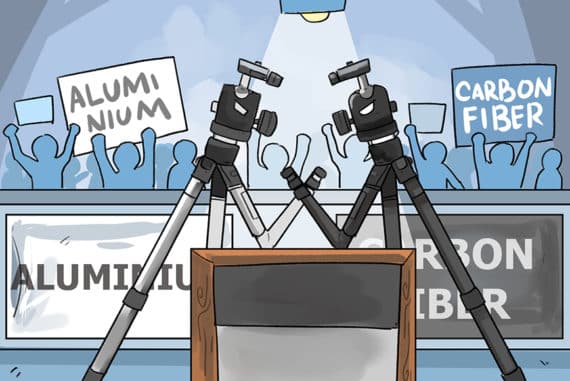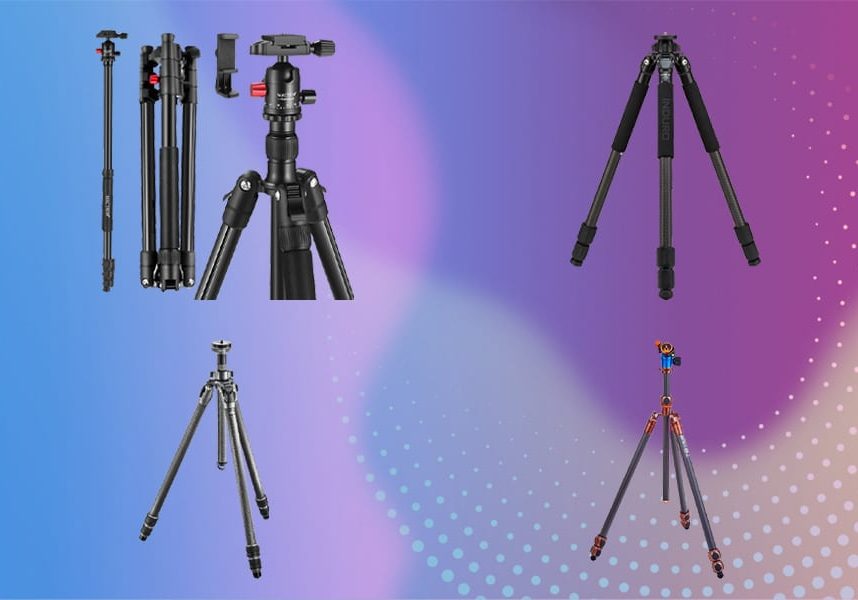
Best Heavy Duty Tripod Stand for Heavy Camera & Lenses
Need to support a heavy camera + lens? To get the sharpest photo, you need to choose a heavy-duty tripod that can support the weight. Here are the best ones.
If you shoot landscape, sports, astrophotography, or wildlife photography, you definitely need a heavy-duty camera tripod.
A sturdy tripod can be the difference between a sharp image and a blurred one, particularly if your camera or lens is heavy.
Despite the emergence of lighter mirrorless cameras, long telephoto lenses are still heavy and require heavy-duty tripods with a larger maximum load capacity.
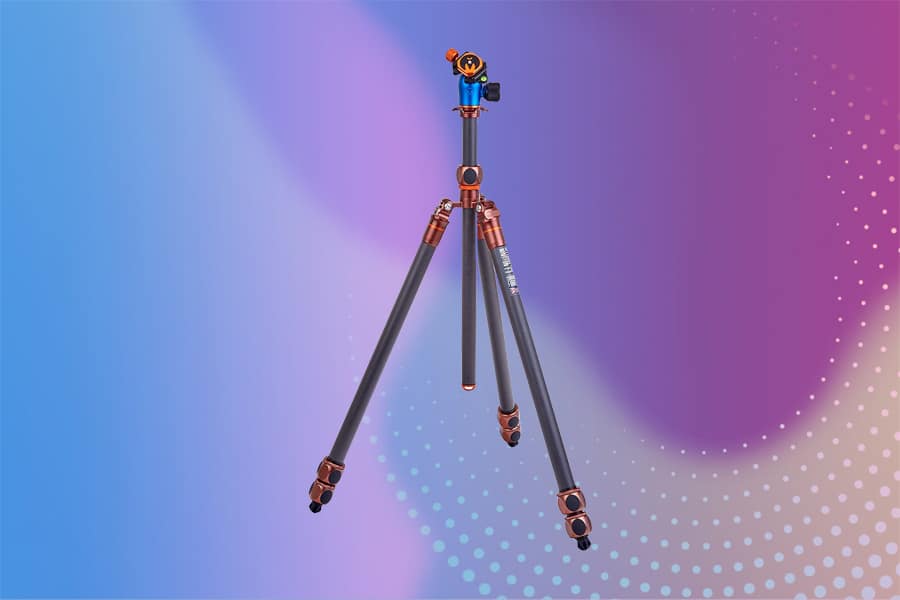
Super strong, stable and packed full of features. Great value for money with included ball head and monopod convertibility.
In this guide, you’ll discover various affordable aluminum and carbon fiber tripods that are strong enough to support heavy camera + lens setups.
Remember – with tripods, you get what you pay for – a heavy lens or camera usually means it’s expensive, so don’t skimp on tripod quality unless you want an expensive disaster!
Let’s take a look at the top recommendations.
4 Best Value Heavy Duty Tripods in 2024
| Image | Product | Features | |
|---|---|---|---|
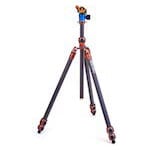 | 3 Legged Thing Winston 2.0 Carbon Fiber Tripod BEST ALLROUND |
| View Price → |
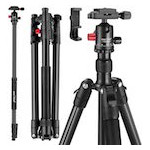 | Mactrem Heavy Duty Aluminium Tripod BEST BUDGET |
| View Price → |
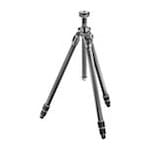 | Gitzo GT2532 Mountaineer Series 2 Carbon Fiber Tripod |
| View Price → |
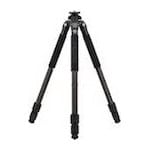 | Induro CLT203 No.2 Stealth Carbon Fiber Tripod |
| View Price → |
1. 3 Legged Thing Winston 2.0 Carbon Fiber Tripod with Ball Head
- Insane 88 lb(40kg) maximum load capacity
- Excellent stability
- Converts to a tabletop tripod
- Removable legs convert to monopod/boom
- Parallel locking
- Carrying case with shoulder strap
- No accessories thread on crown
- No safety mechanism for quick release
The 3 Legged Thing Winston 2.0 heavy duty camera tripod is one of the most stable heavy-duty tripods that’s also surprisingly lightweight and portable too.
It features a height range from a minimum of 5.7″ (146 mm) to a maximum height of 76.4″ (1.94 m). The max height is one of the tallest available from a full-sized tripod with a compact design.
It has a neat and compact folded length of 24″ (612mm) and weighs only 4.51lb(2.05 kg), making it super portable for photographers on the go. This is a decent weight for a tripod that can support super heavy lenses.
If you’re shooting long exposures with a large DSLR body and heavy lenses, the 3 Legged Thing Winston will handle evertthing with impressive stability.
It can support up to 88lb! (40kg) and hold as steady as you need, thanks to the parallel locking mechanism.
All three legs are removable and convert to a monopod or boom arm. 3 Legged Thing has a range of feet and metal spikes available to replace the legs and create a stable tabletop tripod system.
The center column is telescopic to provide optimal reach and height adjustment, although extending it fully will obviously bring some stability issues depending on the load and the surface on which it’s placed.
It’s hard to beat the Winston when looking for the best heavy-duty tripod – 3 Legged Thing really know what they’re doing when it comes to tripods. You should also check out the Charles 2.0.
2. Mactrem Heavy Duty Aluminium Tripod with 360 Degree Ball Head
- 33 lbs(14.9kg) maximum load
- Budget-friendly
- Lightweight tripod at 2.9lbs (1.32kg)
- 90-degree tilting ball head
- A little short
If you’re on a budget, the Mactrem Heavy Duty Aluminium Tripod with 360 Degree Ball Head is for you.
The Mactrem is a lightweight and compact tripod that will support a hefty camera and lens kit on uneven ground. The tripod is lightweight at just 2.9lbs (1.32kg), allowing you to transport it anywhere you go.
This aluminum tripod features a folded length of 17.5″ (44.45cm), a minimum height of 21.5″ (54.6cm), and a maximum height of 62.5″ (158.75cm). While not the tallest max height, it’s a great value tripod for supporting heavier landscape photography cameras and for general portrait photography work.
Among its list of features, the Mactrem tripod is extremely rigid and includes an Arca-swiss compatible Quick Release Plate, flip locks, leg sections, removable monopod, and legs that fold up to 180-degrees.
The center column flips in just a few seconds to hang your camera upside down for low-angle photography and macro photography.
It’s one of the best budget-conscious aluminum tripods with a surprisingly good weight capacity.
3. Gitzo GT2532 Mountaineer Series 2 Carbon Fiber Tripod
- Supports up to 39lbs (17.6kg)
- Lightweight tripod at 3.7lbs(1.68kg)
- Reversible center column
- Wider legs with twist locks
- Legs only – no ball head
The Gitzo GT2532 Mountaineer Series 2 Carbon Fiber Tripod is a brilliant example of the quality and precision engineering you can expect from a brand leader in the tripod space.
Constructed from carbon eXact, this tripod is one of the most stable for large camera/lens combos and effortlessly supports 39lbs(17.6kg). The Gitzo is the best tripod for heavy lenses that assures enhanced stability for your heavy lenses and DSLR with a battery grip.
All this from a tripod that weighs 3.7lbs(1.68kg) and has a folded length of 25.59″ (65cm).
The Gitzo GT2532 Mountaineer has a minimum height of 6.3″ (16cm) thanks to the reversible center column, making low-angle shots for macro photography are a breeze.
The maximum height is 166cm making the Gitzo ideal for studio and landscape work when a full extension is often preferable.
A good value ball head to pair with the tripod is the Induro Tripods BHL2S – a durable and sturdy ball head with an Arca-Swiss style quick-release system and smooth 360-degree panning action.
4. Induro CLT203 No.2 Stealth Carbon Fiber Tripod
- 35.3 lb (16 kg) load capacity
- Carbon Fibre
- Twist Locks
- Sturdy center column lock
- Legs only – no ball head
- Centre column not removable
The Induro CLT203 No.2 Stealth Carbon Fiber Tripod is a durable and super stable heavy tripod for your DSLR kit. Each of the carbon fiber legs features 3-sections with twisting locks for quick setup and takedown.
It makes our heavy-duty tripod guide due to its enhanced stability and useful 35.3 lb(16 kg) load capacity.
The Induro tripod has a folded length of 24.61″ (62.5cm) and weighs just 3.48lb (1.58kg), allowing you to strap it to any camera backpack when out and about adventuring.
It’s a flexible arrangement with legs that lock at three leg angles, a minimum height of 14.76″ (37.5cm), and a max height of 63″ (160cm).
Induro also develops durable tripod heads such as the aforementioned Induro Tripods BHL2S Ball Head that features an Arca-Swiss style quick-release system and smooth 360-degree panning action.
How to Choose a Heavy-Duty Tripod
When you’re shopping for a stable heavy duty tripod for cameras to support the weight of your heavy camera + lens photography setup, there are several things to consider.
In the guide below, professional landscape and astrophotographer Matthew Saville gives us his advice on making the right decision.
1) Twist Lock vs. Lever Lock
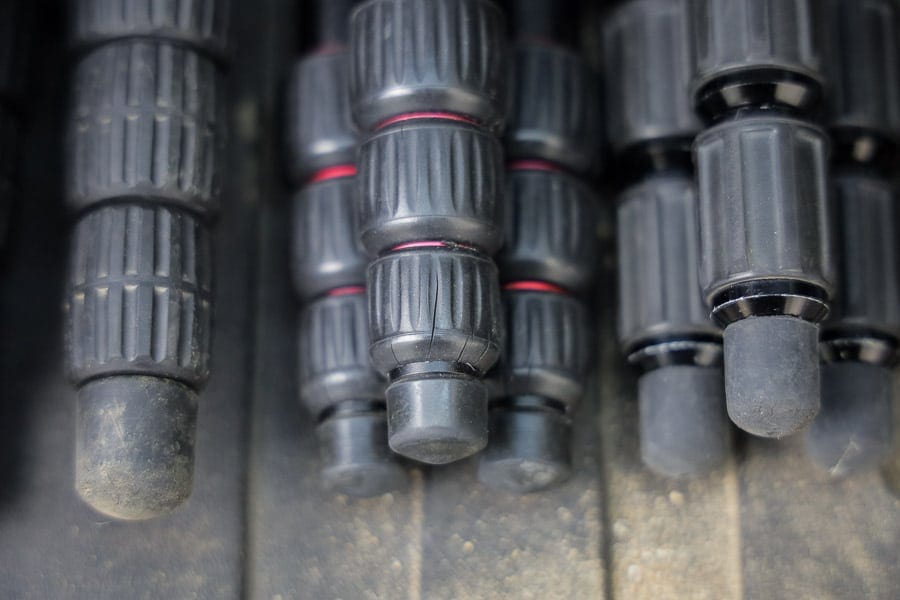
An assortment of Slik and Giottos tripod legs with twist-lock leg joints with rubber feet
One of the most strongly debated aspects of tripod design is twist-lock leg joints vs. lever-lock (flip locks).
In my opinion, this is a matter of preference. Both have advantages and disadvantages. Both can be very strong and reliable, and both can have incidents of total failure.
The biggest deciding factor between these opposite scenarios lies with the quality of the tripod itself.
Lever-lock leg joints generally never have issues with the lower legs getting twisted and jammed, which is a very nice plus in favour of lever-lock design.
However, lever-locks only “pinch” the tripod leg in one place where the lever is, and therefore if a lever-lock does fail on one or more legs, it may cause the immediate crashing of your entire tripod, instead of a slow slipping that might give you an extra second or two to grab your camera.
Twist-lock leg joints, on the other hand, use friction adjustment and clamp the whole tripod leg to make the leg stiffer overall.
They can still fail, of course, by simply not being fully tightened or by actual mechanical failure with a full load capacity. Either way, if they do fail, they usually slip slowly instead of collapsing instantly.
Any kind of tripod leg lock failure is bad though and can happen in just a couple of seconds. Therefore, the best thing you can do is buy a good quality tripod and make sure your legs are truly locked before you attach your camera.
2) Number of Tripod Leg Sections
The more leg sections a tripod has, the more flex it will have, making it hard to precisely frame a shot with heavier DSLR cameras and heavy lenses. It can even cause blur in the images, so it’s all the more important when shopping for a heavy-duty tripod.
Remember: one more leg lock per leg is three more points of potential failure.
A tripod that has just three or four leg sections (two or three locks) per leg is optimal to enhance stability but typically has a longer folded length. Tripods that have four locks, or five leg sections per leg, are usually a massive compromise on rigidity. Avoid them at all costs!
Thankfully, most tripod brands offer more than one option. Only a few brands offer nothing but 5-section legs, as they brand themselves as a maker of compact travel tripods.
Ironically, their tripods are actually bigger and heavier than many other travel tripods.
3) Leg Lock Materials
Both twist-lock and lever-lock tripod leg joints can be made of cheap quality plastic, high-quality plastic, or even metal. As you might imagine, cheap plastic lever-locks can easily break…
However, the problems with twist-locks are almost equally bad: the thin plastic shims and locking spacers in a twist-lock leg can fail and/or jam, causing both long-term frustration and abrupt complete failure.
Keep in mind that your tripod must carry your DSLR and heavy lenses at max height and full load capacity.
Simply put, avoid cheap plastic materials. Stick with name-brand options that have a long track record of surviving years of abuse by the types of photographers who use their tripods daily.
4) Tripod Center Columns
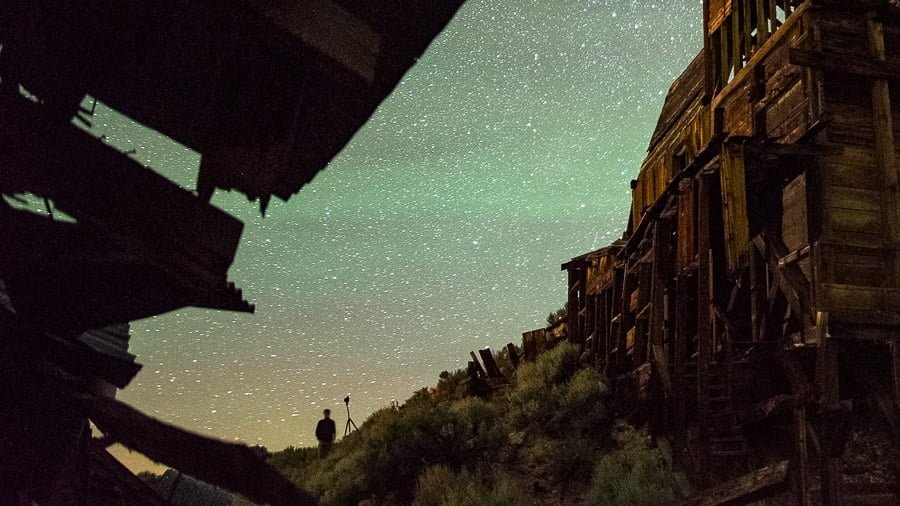
I only ever extend my center column when conditions are extremely calm and when the composition absolutely requires it
Avoid using a center column as much as possible. A center column is only a good idea when you absolutely need extra height, once in a while.
Your every day, most-used tripod should be tall enough that you can use it at eye level with the center column down.
Never use a tripod with a double-jointed center column or a “permanently up” center column. Simply put, a center column is too much of a compromise for both your image sharpness and the actual safety of your camera, and there are better options out there for lightweight travel tripods that don’t require such a compromise.
5) Tripod Leg Material: Carbon Fiber vs. Aluminum
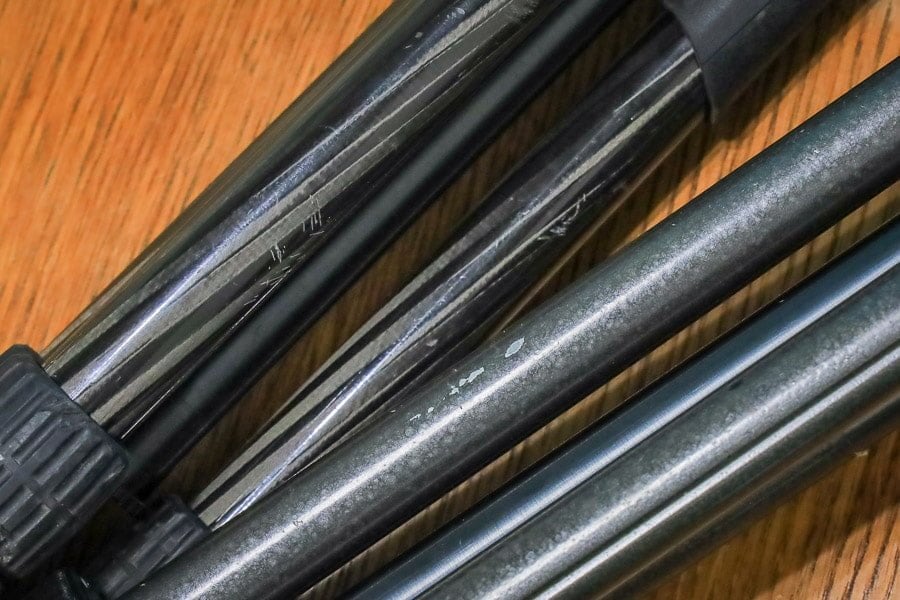
Carbon Fiber is lighter and stiffer than aluminum. However, aluminum is both more affordable and in some cases even more durable.
As far as tripod leg materials are concerned, the carbon fiber vs aluminium tripod debate rages on! In truth though, both materials have certain advantages.
Aluminum is affordable and quite indestructible when it comes to absorbing general scratches and dings.
Carbon fiber, on the other hand, is not only lighter but also stiffer and less prone to that “vibrato” that legs can get in windy conditions.
I will say this: I would rather have a name-brand, sturdy, stiff aluminum tripod than a wobbly, cheap generic brand carbon fiber tripod.
I have seen too many “basic” carbon fiber tripods utterly fall apart, or become very wobbly with a full load capacity.
While I do recommend carbon fiber for anyone who has over $300 to spend and is looking for a lightweight, strong tripod, if you’re on a budget, I would stick with the name brands even if it means getting an aluminum version instead of carbon one.
Name Brands such as Manfrotto and Slik both offer similar versions of their tripods in carbon and aluminum.
6) Tripod Leg and Head Grip Rubber Material
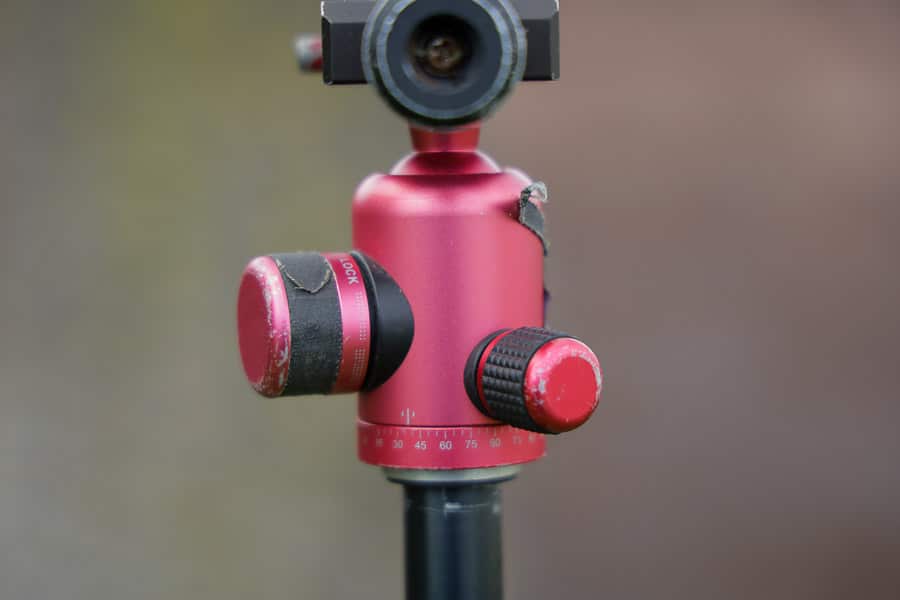
Giottos ball head: One locking knob lost its rubber after just a few months, hence the gaff tape. The other is cracking too.
If you ever leave your tripod in the sun for too long, (let alone in a hot car trunk for even just a few hours!), you may ruin the grip rubber on the leg locks and/or the tripod head’s locking knobs.
In fact, on literally all of the non-name-brand camera tripods I’ve ever tested, these rubber parts eventually “melt” and start slipping, (making it impossible to safely lock them) …or they’ll dry out and crack and fall off completely.

The cheaper the tripod brand, the sooner the grip rubber will crack or melt, such as on this “fake” Giottos tripod from eBay.
Only the best brands seem to have rubber parts that stand the test of time. My personal favourite? Any tripod brand that has all-metal knobs and lock grips!
These brands include (most) FLM tripods and heads, almost all Oben ball-type heads, and a few other brands that make heavy-duty tripods.
7) Tripod Size & Weight
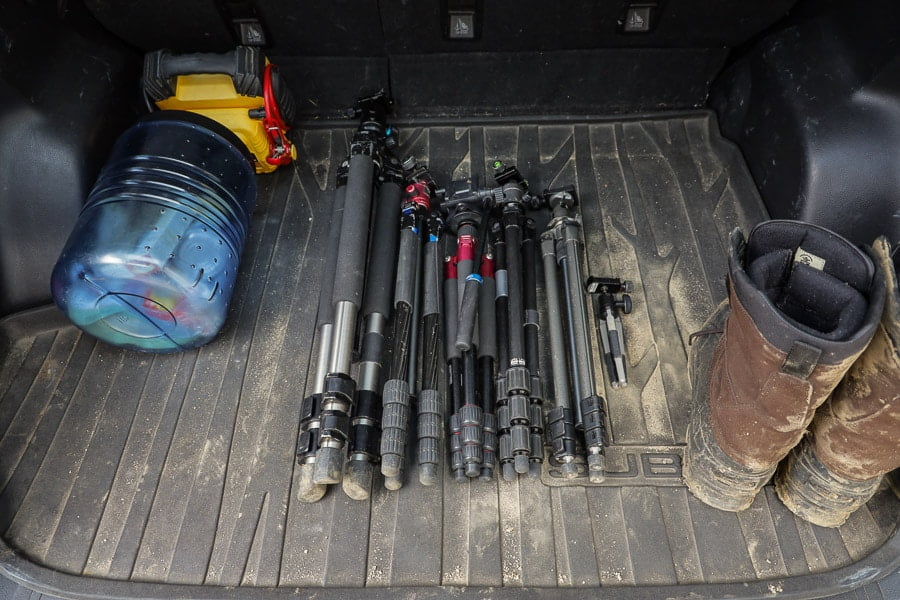
All shapes and sizes: just a small part of my tripod collection, including Slik, Giottos, and Manfrotto tripods
In case it isn’t already apparent, tripods of all weights and sizes can be useful. As a dedicated landscape and adventure/travel photographer, I’m a firm believer that there is no perfect size/weight tripod for everything that a serious photographer may do.
Your best first investment is likely to be a relatively medium-weight, tall tripod. It should be light enough so you don’t feel inclined to leave it at home, yet tall and strong enough that it can handle your biggest camera and lens without difficulty.
If you put a lot of wear-and-tear on your tripod almost daily, such as shooting on the beach with saltwater and sand repeatedly getting on your tripod leg locks, you may want to consider getting a big, heavy-duty tripod – one that can just be rinsed off under a shower or spigot afterwards, to clean off salt residue and other nasty stuff.
How heavy should a tripod be? Most DSLR tripods weigh less than 10 lbs, and most travel tripods weigh less than 5 lbs. The weight you choose should reflect how you plan to use it – hiking up a mountain will require something lightweight, for example.
If you’re wanting to make your tripod heavier when shooting on unstable ground or high winds, you can usually hang your camera bag from a hook under the center column if there is one.
By their nature, heavy-duty camera tripods are usually heavier and bulkier than other models, so this will help you keep a stable shot in adverse conditions. They will also support a heavier load capacity, especially when shooting on uneven surfaces.
8) Tripod Height
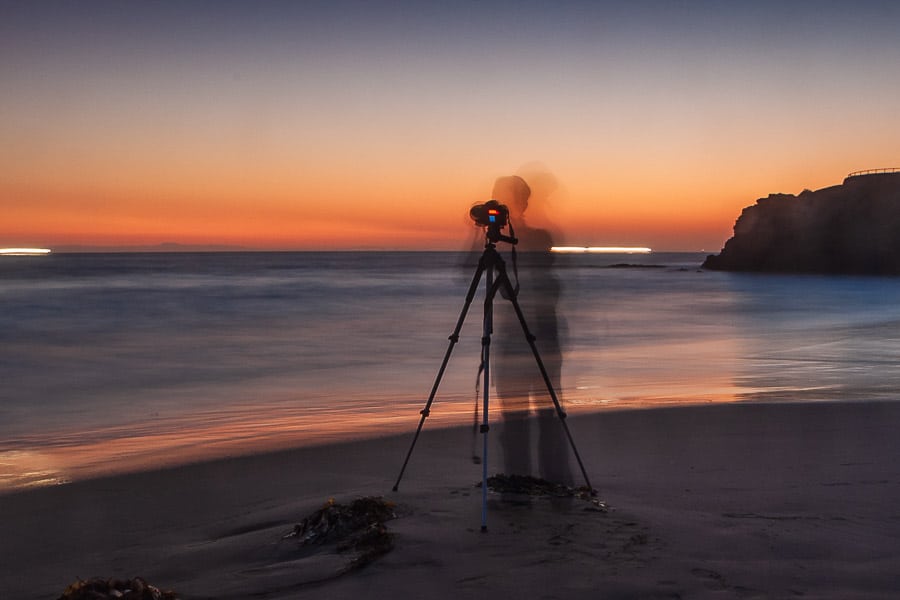
Your most-used tripod should reach eye level without the center column extended, such as this Manfrotto 190X Pro.
My best advice for choosing a stable tripod is to make sure you get one that reaches your eye level, preferably without using the center column.
If your camera doesn’t have an articulated LCD that allows you to look at it without hunching over such as the Nikon D750, then even a few inches to the max height can make a world of difference and save you some major back pain in the long run.
9) Tripod Feet
Tripod feet are another consideration when choosing a heavy-duty tripod. There are a few basic designs, each with various advantages.
i) Rubber-tipped feet are friendlier to your floor if you ever use the tripod indoors and especially on tile or wooden floors.
ii) Some tripods offer metal spiked feet, for really gripping outdoor surfaces, from soft dirt to hard rock.
Many tripod brands now offer retractable spikes, meaning you can screw the foot one way to have a rubber foot, or screw it another way to expose a metal spike.
However, on cheaper brand tripods, this is just another thing to go wrong- eventually, the rubber feet will fall off and you’ll be left with just the spikes. This is just another reason to get a good quality tripod, even if it only comes with rubber feet, or if metal spiked feet are an aftermarket accessory.
iii) Some tripods offer specialty feet, such as sharp claws for really grabbing rocks or to minimize sinking in sand and snow. (Really Right Stuff makes these; watch out though – they’re razor-sharp!)
10) How do I choose a tripod head?
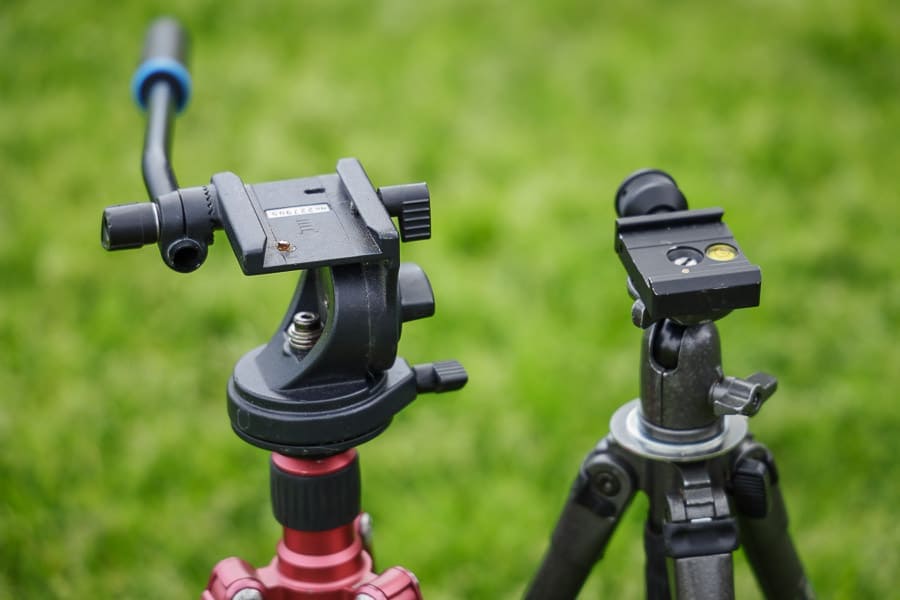
Left: Benro Video (3-way) head. Right: Slik Mini Ballhead (1 locking knob only)
While many heavy-duty tripods do come with both a set of “legs” and a “head” together, some of the best choices might be sold as legs only, without a head.
You don’t necessarily have to buy tripod heads and legs separately, but let’s discuss the different types of heads so that you can make sure to buy what’s right for your type of photography.
- Ball Heads
Ball heads are simple: One knob loosens and tightens the entire thing, allowing you to freely compose your frame with much flexibility.
The better tripod heads do offer separate locking knobs for side-to-side panning motion, and possibly even an additional knob to adjust the overall tension of the main locking knob.
I recommend looking for a tripod head with both a main locking knob/lever and a separate panning lock.
- 3-Way Panning Head
The other most common type of head is the 3-way panning head. These heads allow you to separately control the angles of your camera, to more carefully compose your shot. They’re usually a little bigger and more cumbersome than ball-type heads, but they offer better precision that can be very useful.
Many 3-way heads also offer a large panning arm, for smoothly panning your camera up, down, left, or right when recording video. It’s an ideal feature for shooting with heavy lenses too.
If you’re a run-and-gun type of photographer, however, we do recommend heads for their speed and portability.
- Gimbal & Nodal Heads
Lastly, for the truly enormous telephoto lenses, and for panoramic stitching, nodal and gimbal heads offer a unique benefit – they allow you to freely move your camera around while keeping it perfectly balanced, and/or keeping it over the nodal point of the lens which makes panoramic stitching almost effortless.
These types of heads are usually the biggest and most expensive, however, so I don’t recommend them as your very first investment.
11) Tripod Head Quick Release System
Thankfully we can keep this simple: Arca-Swiss is the universal clamp system for photography, and your best bet is to adopt it.
Arca-Swiss is based on a 2 piece mechanism, with a ‘plate’ attached to a camera or a lens, and a ‘mounting base’ or a ‘clamp’, where the plate gets attached and secured.
With Arca-Swiss, you can freely swap most camera plates and tripod head clamps, making it very convenient to use multiple tripods and just leave the plate attached to your camera.
Arca-Swiss also offers L-brackets, which allow for quick vertical mounting of your camera.
There are other, proprietary tripod quick release plate systems, and the smaller ones should be avoided as they just won’t support much more than a GoPro or small point & shoot camera.
Manfrotto has two different proprietary quick release plate systems, both of which are very sturdy, one made for photographers and the other is quite universal for videographers. However, unless you’re a serious videographer, I recommend sticking with Arca-Swiss.
12) Bubble Levels
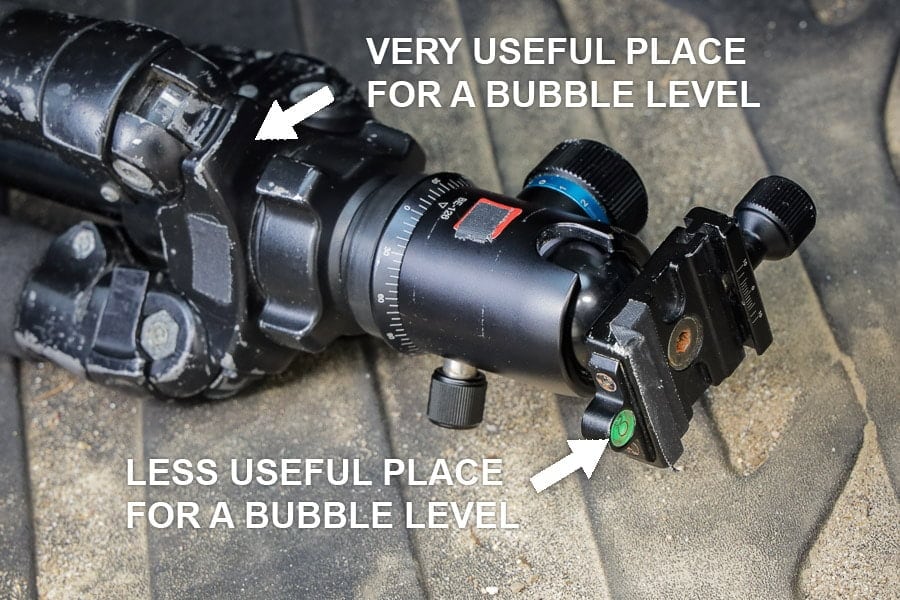
Not enough tripods have a bubble level in the “perfect” spot.
Most cameras have digital levels these days, so why would you need a bubble level on your tripod itself?
A perfectly level tripod can be helpful for creating perfectly level panoramas very quickly, instead of having to re-level the camera for every single frame of a pano.
For this, ignore most bubble levels that are placed randomly around the ball head; they’re not nearly as useful as having a bubble level on the tripod base itself.
13) Tripod Cost, Budget & Value for Money
As the saying goes, “buy the expensive option once, and it will only hurt your wallet once. Buy the cheap option, and it may hurt twice, or more…”
In other words, when setting your budget for a tripod, you should consider the long-term cost. A tripod that breaks after just 1 year, but costs more than 1/3 the price of a tripod that lasts 3-5+ years, is simply not a good value.
So, if you can’t afford a good tripod right away, just keep saving up.
Having said that, while saving for your more expensive tripod, there are numerous options you can purchase in the meantime at very affordable prices. It won’t be wasted money in the long run, because the tripod will become a backup or secondary tripod if you ever save up for a nicer one.
Final Words
Buying a sturdy tripod that’s strong enough to handle your heavy camera and long telephoto lens needn’t be so complicated.
Despite the length of this guide, your decision really only boils down to tripod quality (read buyer reviews on Amazon), maximum load capacity, and your intended use.
The best tripod is a personal choice based on the kind of photography you wish to shoot and where you want to shoot it.
Investing in big-name brands may make the best sense to you if you plan to use the tripod frequently, but the lesser-known brands introduced in this guide are great value for money too.
Happy shooting!

Super strong, stable and packed full of features. Great value for money with included ball head and monopod convertibility.





